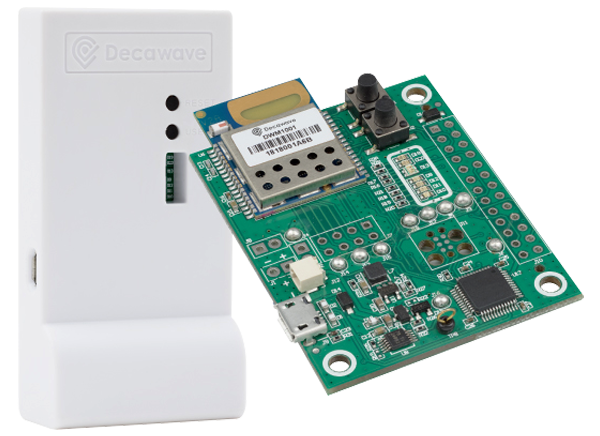Global positioning systems (GPS) technology changed the world. So too will ultra-wideband (UWB) position-tracking capabilities. In the following, we’ll explore how UWB’s fast updates, shorter latency, and 1cm accuracy will enable both Internet of Things (IoT) and mobile devices to be accurately tracked and combined with data in personal, public space, and industrial applications.
First, a Little Background
Younger generations might take it for granted, but people marvel today over GPS technology and its ability to resolve location as a navigational aid. Although initially a military technology to aid soldiers and Special Forces perform secret missions, its use today is so common that using traditional paper maps is no longer as common as it used to be.
GPS kicked off in 1973, but it wasn’t until 1993 that all 24 geosynchronous satellites were in place to support a real, usable correlatable global positioning system that required no transmitted signals from the user. This was particularly important to the military because it helps preserve the stealthy nature of many missions by eliminating traceable radio signals.
The early worries that foreign forces could take advantage of US-developed GPS systems resulted in a program called selective availability, which limited resolution and effectiveness. Selective availability lasted around ten years while other countries created their global positioning systems, such as the Soviet GLONASS and the Chinese BeiDou system, and the European Galileo GPS. When selective availability was eliminated, GPS could achieve approximately 5m of positional accuracy, making it useful for the masses as a navigational aid while driving. With the merging of GPS into cellphones, continuous improvements in geolocation now allow GPS systems to get approximately a foot—or within 30cm—of spatial resolution.
Cellphone towers allowed service providers to use signal strength, phase relationships between towers, and now Time of Flight (ToF) information that measures how long it takes for a signal to travel to the different towers in range. This triangulation technique enhances the position system accuracy, and modern-day devices can even use Wi-Fi® beacons to help improve accuracy. The use of Bluetooth® and Wi-Fi even permits a few meters of positional accuracy with an indoor location. I tested this and found that when I overlaid my position on Google Earth maps, it not only told me whose house I was in, it also pinpointed to the exact room.
Between GPS, cell tower data acquisition, beacons, and Wi-Fi/Bluetooth signaling, 12 inches of resolution is great for many needs, but higher resolutions are coming because of technological advancements, new use of RF bands, and new applications of existing technology. Ultra-Wide Band (UWB) technology, which can provide detailed location data and position accuracy down to the 1cm resolution, is gaining a lot of traction. Called microlocation, we can now locate and find anything in real-time with centimeter accuracy because of UWB’s ability to work across platforms and anchor itself into the world of wireless technology.
Modern-Day UWB
In the mid-2000s, IEEE began defining the UWB specification to enhance micro-positional system accuracy and real-time location services (RTLS) for multiple targets. UWB was chosen because it’s secure and features high immunity to noise and spurious signals and is immune to multipath signal interference. The result is the IEEE 802.15.4a and 802.15.4z standards.
Operating at 3.1GHz to 10.6GHz and using orthogonal frequency-division multiplexing (OFDM)—orthogonally closely spaced subcarriers with overlapping spectral characteristics that can carry data in parallel—UWB can penetrate nonmetallic walls and floors and does not have to be in the line of sight like 5G. Also known as pulse radio (2nsec wide high amplitude 500MHz band bursts of data), UWB rides above a noise floor and presents an easily accessible signal to recover and decode compared with narrowband (Figure 1).
Figure 1: High-amplitude pulse radio signals of UWB typically ride above the noise floor, even in the presence of other RF communications. (Source: Qorvo)
UWB also provides much more reliable, secure, and real-time data than GPS technologies. UWB position data can be updated 1,000 times per second, which is 50 times faster than satellite navigation systems.
Because of the accuracy of ToF measurements and the wide bandwidth, multiple devices can be communicating and tracked simultaneously without interference. This can help eliminate the stadium effect that limits performance in densely populated areas, such as Wi-Fi in stadiums. This also allows UWB to be embedded in a slew of new devices aimed at IoT and automation technologies inside houses, apartments, factories, and public locations such as airport terminals. Imagine looking at your phone to find where your friends are in a huge airport or where your gate is when changing planes.
Already, cellphone makers and industrial equipment makers are working together in the FIRa Consortium to smooth out protocol definitions and eliminate interoperability issues. Apple and Samsung are among the first to integrate UWB into their new phones. The consortium is architecting the structure to support hierarchal aggregated access points that use initiator and responder sequences to minimize latency (Figure 2). Personal area networks can use anchors in a fixed location to support aggregation, gateway functions, routing functions, and a peer-to-peer handoff to adjacent access points for a seamless transition from one location to another. In addition to public-access locations where fixed and mobile nodes are in play, UWB technology is also suitable for industrial functions. Industrial sites can use UWB tags to track assets and inventory, locate items on a conveyor, and even send critical data such as the temperature of a container that holds a vaccine.
The UWB technology allows virtually any sensor, actuator, fixed or mobile, to coexist within a given volume with mobile devices that move from volume space to volume space. This includes access to cloud-based services that can typically devote more processing resources and artificial intelligence (AI) to critical tasks such as self-driving vehicles, delivery robots, self-functioning agricultural systems, drones, contact tracing, and even patient-location-monitoring for dementia and Alzheimer patients in a care facility.
Figure 2: Public spaces can be loaded with UWB nodes that function together to weave a personal area network for public spaces. (Source: Qorvo)
UWB Products and Toolkits
For designers interested in implementing a UWB system, there are tools and components at their disposal to help teach the technology, provide reference hardware, firmware designs, and help ensure that the system is compliant with industry standards.
Based on the DW1000 UWB transceiver IC and compliant to IEEE802.15.4-2011, the DWM1001C UWB Transceiver Module supports data rates up to 6.8Mbits/sec. DWM1004C integrates a UWB and Bluetooth® antenna, all RF circuitry, Nordic Semiconductor nRF52832 MCU, and a 3-axis accelerometer. Each mode can be configured as an RTLS anchor or tag and additionally can act as a network gateway device.
UWB demo and development tools specifically aimed at position and distance measurement are in production in addition to antennas and signal-conditioning components. The Qorvo MDEK1001 Development Kit is a great starting point to get a feel of an RTLS system. The MDEK1001 Development Kit provides designers with the necessary hardware, software, and development environment to quickly evaluate Qorvo’s UWB technology for use in a scalable RTLS. The kit includes 12 DWM1001-DEV development boards, which can be configured as an anchor, tag, or bridge node.
Figure 3: The Qorvo MDEK1001 Development Kit enables designers to quickly evaluate Qorvo’s UWB technology for use in a scalable RTLS.
The DWM1001-DEV Module Development Board evaluates the performance of the DWM1001 module. Designers can use the DWM1001-DEV Module Development Board to assemble and evaluate an RTLS, including anchors, tags, and gateways without developing any hardware or writing a single line of code.
Conclusion
Just like the introduction of GPS changed the world, highly accurate UWB position-sensing technology is on the cusp of doing the same thing. As interoperability gets more refined and as tags get smaller and cheaper, you might never lose your keys again.











